From its humble beginnings as a bread and butter species, Acanthopagrus australis, or as it’s better known the yellowfin bream, is one little fish whose reputation has recently outgrown its size.
Influences, such as the ABT Tournaments, have increased the modest little bream’s exposure. This has spawned an industry focused on delivering innovative tackle and equipment to anglers who have an emphasis for catching these spirited fish on artificial presentations.
We all enjoy challenging our fishing techniques and skills to the point where frustration becomes overwhelming, particularly when our peers are flaunting remarkable catches on a newly introduced method. Not being able to crack the latest fishing code through months of tribulations has the potential to leave anglers with personal doubt over their fishing ability. This self-doubt is even more evident within the travelling tournament fraternity. Learning every waterway has different structure and bream holding locations are the biggest hurdle for anglers to cross before consistently finishing at the top of the leader board.
Bream are formidable light tackle opponents that are available and accessible to every angler living along Australia’s coastline – the number one reason why they are the focus of tournament organisations. They have a tendency to switch from aggressive feeding frenzies to an easily spooked skittishness in the instance of a cast. This can break even the most experienced fisher’s spirit (no-doubt the second reason why they are popular with tournament events).
Bream anglers that apply a basic understanding of bream habitat are much more successful than their counterparts. Whether using new or old methods it is more about finding the fish, then getting those fish to actually feed. It may sound simple and some days it is, but other days you wish you’d just stayed in bed!
In the following, I will look at the basics of bream fishing and endeavour to solve a few quandaries that often arise during tough days on the water.
I recently dragged out a heap of my old reference books and quickly came to the realisation that every author has a different idea of where we should be fishing for bream. Bream are so wide spread that potentially any waterway, with or without structure, can hold them. This makes finding fish easy and hard at the same time.
However, there are consistencies that exist amongst the theories. Having good nutrient rich tidal flow, adjacent deeper water and an abundant food supply can equal schools of waiting bream.
Bream definitely enjoy haunting areas with good tidal flow; strong currents wash small baitfish and molluscs away from safety and also bring in cleaner water, making visual hunting easier. Deep water acts as a quick retreat for bream as well as another good supply of food when the tide begins to run. Lastly, the most important of the three elements, food supply, is often the easiest and most obvious element to find. Having good shoals of small baitfish, prawns or other food sources will have bream in very close proximity. All three of these situations can coexist in the same section of a waterway and getting two of the three is often a great place to begin probing.
In my observations over recent years, differing stages of the tide are more important for where to begin looking for bream.
In low tide bream tend to move into deeper water with reef or rocky bottom structure, this is usually a trying time to get bream to bite as the fish rest from feeding during other tidal phases.
Nevertheless, this doesn’t mean that the bream won’t attack a well presented lure. Focussing on using smaller artificials during low tide can draw aggressive strikes, making a usual ‘down’ period productive. Small vibration blades, like TT’s Switchblade, Ecogear VX series and Evergreen Little Max, rolled close to or along the bottom can create good interest. Likewise, dead-sticking a small worm or creature plastics, like Gene Larew’s Baby Hoodaddy, on the bottom with minor twitches will acquire attention from a normally shy or wary fish.
As the tide begins to run-in, bream begin to congregate in preparation to feed on yabby beds, reef flats or around pylons and pontoons. I have noticed over the last few outings when the sun is out, bream feed more aggressively across the flats. I believe this is because bream are feeding visually and this obviously helps them locate prey and launch an attack from long distances.
As the flood tide reaches about a third of its way in, flicking prawns or fleeing baitfish are the number one food supply. Changing lures to shallow running or surface presentations trigger the bream’s feeding instinct. Targeting the top layer of the water column creates a relatively easy prey for bream and can activate competition from other fish in the school.
Competition is what makes surface fishing the most exciting form of breaming. Watching small schools of big bream darting in less than a foot of water with their backs slicing the surface boofing at your lure is a vision that sticks in your mind forever, leaving you craving more. This is truly the epitome of bream fishing.
Small surface lures, like Tiemco Pencils or Lucky Craft Sammy 65’s, make fishing exciting. Try to make the lures flick like small prawns and give plenty of pauses in the retrieve. If the bream are following your surface baits but are shying away from striking, switch over to shallow running lures, like SPRO Minnow 20 or Lucky Craft Cra-Pea, as this will usually convert follows into strikes. Where the water is deeper (pylons and pontoons) use blade baits vertically with a small twitching retrieve.
Fish the rest of the flooding tide until the fish begin to slow off the bite (usually about the last third of the tide). At this time bream move up into heavy cover like mangrove systems or small creek tributaries to forage on worms and shellfish and can become almost impossible to tempt. This is a good time to tie on hardbody lures and work along the fringing mangrove edges. Any foraging bream will dart out from cover to crunch a passing lure.
Sight fishing to bream is also a tactic that can be used to good results at high tide. Anglers must be exceptionally quiet and minimise movements as high water usually brings in clean water and can make the fish more flighty.
During the run-out tide, fish back over the same grounds as the flooding tide, as only the first two thirds of the tide is when activity is at its peak. Then as the water becomes too shallow for baitfish the bream will retreat back into the deep water to complete the feeding migration cycle.
Remember the key is to find a source of food, current flow and nearby deep water.
A completely balanced outfit is paramount for bream fishing in South East Queensland. What is even better is having two or three of the same balanced outfits. Rigging each combo with different line weights will have most fishing covered for targeting bream throughout the majority of river systems.
The line I prefer to use for fishing the flats is Sunline Basic FC fluorocarbon of 2lb; this line is great for surface fishing in super clear water and when fish are timorous. For vertical jigging heavy structure, like pylons or fishing hardbodies along rocky outcrops, I prefer to use 6lb Yamatoyo Famell SW Super 8x PE braid with about 1.5m of 6lb fluorocarbon for leader.
For all other fishing options, and as a backup, I rig my final outfit with Sunline Basic FC 4lb fluorocarbon and fish it straight through to the lure. This is useful for fishing all areas including where high losses of jigheads are encountered as it allows for more fishing time and no need for retying leaders.
As a good tip, when spooling up with your new line be sure to back it with a lesser grade nylon line, you will only need 100 yards maximum of top-shot, this will make your spool of expensive braid or fluorocarbon last twice as long.
Good rods are more an angler’s bragging right. A rod built specifically for casting ultra light lures with a good flexible tip and a medium action is a great place to start. High modulus carbon blanks give good ‘feel’ for light bites and are thinner in diameter.
For my breaming, I use an Australian Rod Manufacturers custom-built 1-4kg Estuary Assassin (SJ701). These are great overall rods with plenty of guides that help to reduce wind knots when repetitively casting with light lines and don’t weigh heavily on you hip pocket.
Reels can be the most expensive item for anglers to invest in. Reel sizes from 1500 to 2000 are ideal and not usually heavy enough to give casting lure anglers repetitive strain injury.
Daiwa have a great range of medium level reels that are equipped with super smooth drag systems. This is ideal as ultra light lines are mostly used for breaming, so smooth drags are a must. Jerky or tight drags will quickly break light lines when good fish strike hard.
Daiwa Tierra’s 2000 fits this criteria well for me and it has never faulted under heavy fishing pressure. The Tierra has an oversized drag washer system and can apply minute drag adjustments for finessing bream.
There are so many new ‘u-beaut’ hardbody lures on the market and most of them will catch bream, so trying cheaper generic products is a great money saver while experimenting.
However, for those that need the labels the must-have bibbed hardbody lures for most bream fishing situations are SPRO Minnow 20, Lucky Craft Cra-Pea Deep and shallow, Jackall Chubby in both deep and shallow, and Ecogear SX40.
Top-water hardbody lures can also be a great investment for exciting fishing sessions. Tiemco pencils and River2Sea Bubble Pop 45 or smaller are great bream attractors. Fishing vertical pylons or deep reef structures, vibration baits are a must have inclusion to you tackle arsenal.
This is only a small insight to bream fishing, time on the water equates to understanding Acanthopagrusaustralis, so what better reason to get out and learn while catching a few fish at the same time.
Reads: 18274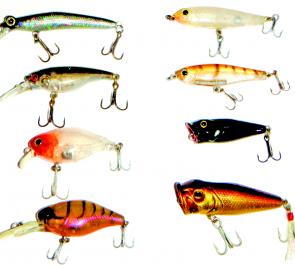
A small selection of proven bream hardbody lures (from left): SPRO Minnow 20, Ecogear SX40, Jackall Chubbies (shallow and deep), Tiemco Pencils, River2Sea Bubble Pop’s.
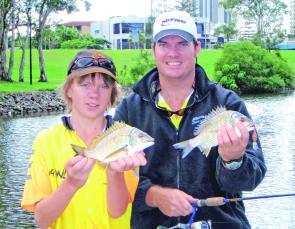
Double header, get one bream excited and the whole school will usually respond.
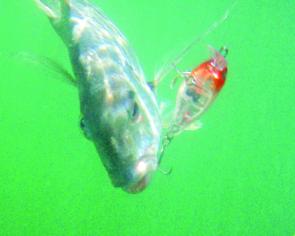
Fishing the flats is extremely productive using shallow running hardbodies.

Flats around river mouths and rocky headlands are prime bream locations when the tide is running out.
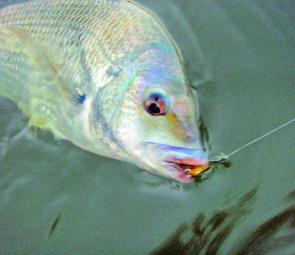
Waiting for the net, another bream succumbs to a vibration bait.
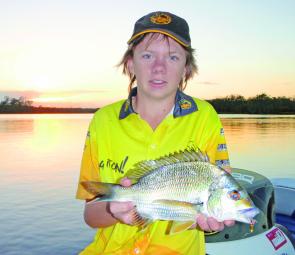
Declan Williams with a great ‘kicker’ bream fishing deep along the pylons.




